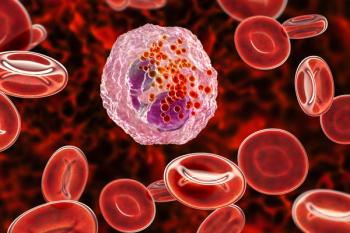Updated at 3:30 pm on August 14, 2024.
Seladelpar (Livdelzi; Gilead Sciences Inc) was granted accelerated approval by the FDA for the treatment of primary biliary cholangitis (PBC) in combination with ursodeoxycholic acid (UDCA) in adult patients who have had an inadequate response to UDCA or as monotherapy in patients unable to tolerate UDCA. The decision is based on positive data from the phase 3 RESPONSE study (NCT04620733) demonstrating seladelpar’s capabilities in reducing alkaline phosphatase (ALP) values.1
PBC is a rare, incurable, chronic inflammatory liver disease affecting nearly 130,000 individuals, primarily women, in the US. It is characterized by impaired bile flow and the accumulation toxic bile acids, leading to inflammation and damaging of bile ducts in the liver. The most common symptoms of PBC are pruritis (itchiness), fatigue, nausea, or poor appetite and weight loss. In cases of worsening liver function, patients might experience edema, jaundice, abnormal bleeding, or confusion. Treatment for PBC is primarily focused in easing symptoms and preventing complications through use of medications to relieve itching and vitamin replacement therapy to restore vitamins lost in fatty stools.2
The approval has the potential to make seladelpar available as a PBC treatment that has achieved statistically significant improvements across key biomarkers, alkaline phosphatase (ALP) normalization, and pruritus versus placebo. It is an oral PPAR-delta agonist capable of regulating critical metabolic and liver disease pathways to regulate bile acid synthesis, inflammation, lipid metabolism, and transport and fibrosis.2,3
In the phase 3 double-blind, placebo-controlled study, researchers randomly assigned participants to receive either 10 mg of oral seladelpar daily or placebo. The primary end point was biochemical response defined as an ALP level less than 1.67 times the upper limit of the normal range, with a decrease of 15% or more from baseline, and a normal total bilirubin level at 12 months. Additional secondary end points included normalization of ALP and a change in pruritus numerical rating scale scores (range, 0 [no itch] to 10 [worst itch imaginable]) from baseline to month 6 among patients with a baseline score of at least 4 (indicating moderate-to-severe pruritus).3,4
About The Trial
Trial Name: RESPONSE: Response to Seladelpar in Subjects With Primary Biliary Cholangitis (PBC) and an Inadequate Control to or an Intolerance to Ursodeoxycholic Acid (UDCA)
ClinicalTrials.gov ID: NCT04620733
Sponsor: CymaBay Therapeutics Inc
Completion Date: August 2023
According to the results, a greater percentage of participants receiving seladelpar achieved the primary and secondary end points of the study. The data demonstrated that participants receiving seladelpar had a biochemical response of 61.7% compared with 20% of participants from the placebo group (61.7% vs. 20.0%; difference, 41.7 percentage points; 95% confidence interval [CI], 27.7 to 53.4, P<.001). The study authors reported a noticeable normalization of ALP levels in the seladelpar group (25.0% vs. 0%; difference, 25.0 percentage points; 95% CI, 18.3 to 33.2, P<.001). Additionally, seladelpar resulted in greater reductions in pruritus numerical rating scale scores (least-squares mean change from baseline, −3.2 vs. −1.7; least-squares mean difference, −1.5; 95% CI, −2.5 to −0.5, P=.005). Adverse events were reported in 86.7% of the patients in the seladelpar group and in 84.6% in the placebo group, and serious adverse events in 7.0% and 6.2%, respectively.4
“More people are being diagnosed with PBC, impacting people of varied ages, gender, race and ethnicity. Those living with PBC share common symptoms, including incessant itching or skin-crawling sensations, as well as debilitating fatigue that is made worse by the itching at night,” Carol Roberts, president of the The PBCers Organization, said in a news release. “The availability of a new treatment option that can help reduce this intense itching while also improving biomarkers of active liver disease is a milestone for our community.”3
References
1. Response: response to seladelpar in subjects with primary biliary cholangitis (pbc) and an inadequate control to or an intolerance to ursodeoxycholic acid (udca). Clinicaltrials.gov. NCT04620733. Updated July 25, 2024. Accessed August 14, 2024. https://clinicaltrials.gov/study/NCT04620733
2. Primary biliary cirrhosis. Penn Medicine. May 4, 2022. Accessed August 14, 2024. https://www.pennmedicine.org/for-patients-and-visitors/patient-information/conditions-treated-a-to-z/primary-biliary-cirrhosis
3. Gilead’s livdelzi (seladelpar) granted accelerated approval for primary biliary cholangitis by US FDA. News release. Gilead. August 14, 2024. Accessed August 14, 2024. https://www.gilead.com/news-and-press/press-room/press-releases/2024/8/gileads-livdelzi-seladelpar-granted-accelerated-approval-for-primary-biliary-cholangitis-by-us-fda
4. Hirschfield G, Bowlus C, Mayo M, et al. A phase 3 trial of seladelpar in primary biliary cholangitis. N Engl J Med. February 21, 2024. doi: 10.1056/NEJMoa2312100







































































































































































































